The 2024 season has been a tale of two halves for Orlando City SC in MLS.
After recording a paltry five wins in their first 20 league games, Orlando City Lions are now on a run that’s seen them win seven of their last ten.
This has seen them shoot up the Eastern Conference standings.
They now sit in fifth place with just four games remaining, having been second from bottom just three months ago.
This tactical analysis and team-focused scout report will provide an analysis of their turnaround in the second half of the season and look at what Óscar Pareja’s men have changed in terms of their tactics to produce this stunning recovery to all but book their place in this year’s MLS Cup playoffs.
Orlando City Lions Barren Start
At the start of the season, Pareja set the team up in their usual 4-2-3-1 scheme from previous seasons: with two holding midfielders, a roaming playmaker behind a lone centre-forward, and two dynamic wide players with supporting full-backs coming from behind on the overlap.
Although the team created enough chances early on, averaging over two goals a game in terms of xG, they weren’t able to find the back of the net with any real consistency.
They also had difficulties at the other end, with several games ending in multiple goals allowed, including the five at Inter Miami on matchday two and three at home to Minnesota United the following week.
Eventually, Pareja decided to try something different: a system allowing him to play with two strikers up front.
He initially switched to a 4-4-2 before eventually experimenting with a 3-4-2-1 throughout the month of May, with an extra centre-back drafted into the side in an attempt to instil more defensive balance.
Although results in terms of points accrued somewhat improved during this period, the team clearly didn’t feel settled into how they wanted to set up, with the system changing several times in a short spell.
Óscar Pareja Tactical Changes Which Lead To A Winning Formula
After the home win against Chicago Fire, Pareja decided to return to his trusted 4-2-3-1 scheme and settled on a core 11, which provided the catalyst for turning their fortunes around this season.
So what changed?
Firstly, the centre-forward position.
With just one player occupying the centre-forward position, this initially continued to be Duncan McGuire up until he went off to Olympics duty for the United States.
After McGuire left, he drafted Ramiro Enrique instead of Luis Muriel as his replacement.
Up until that point, Enrique had not lived up to expectations as the DP striker Orlando was looking to make the difference in their ranks.
Enrique, who missed the first part of the season with an ankle injury, took his chances extremely well, netting in four consecutive games to ensure he stayed in the team even when McGuire eventually did return.
What else changed?
Going back to a back four also meant that Dagur Dan Thorhallsson at right-back and Rafael Santos at left-back took up more defensive duties as full-backs with wingers in front of them rather than being the main sources of providing width in attack for the team.
This resulted in them becoming more of a secondary point of attack from the wide areas with their star man, Facundo Torres.
Iván Angulo moved wider from the inverted forward roles they had in the 3-4-2-1 shape previously, allowing Orlando to space their attacks better and transitions to run smoother with them as wide outlets.
How have they done that?
Let’s look at the data viz below to find some possible answers.
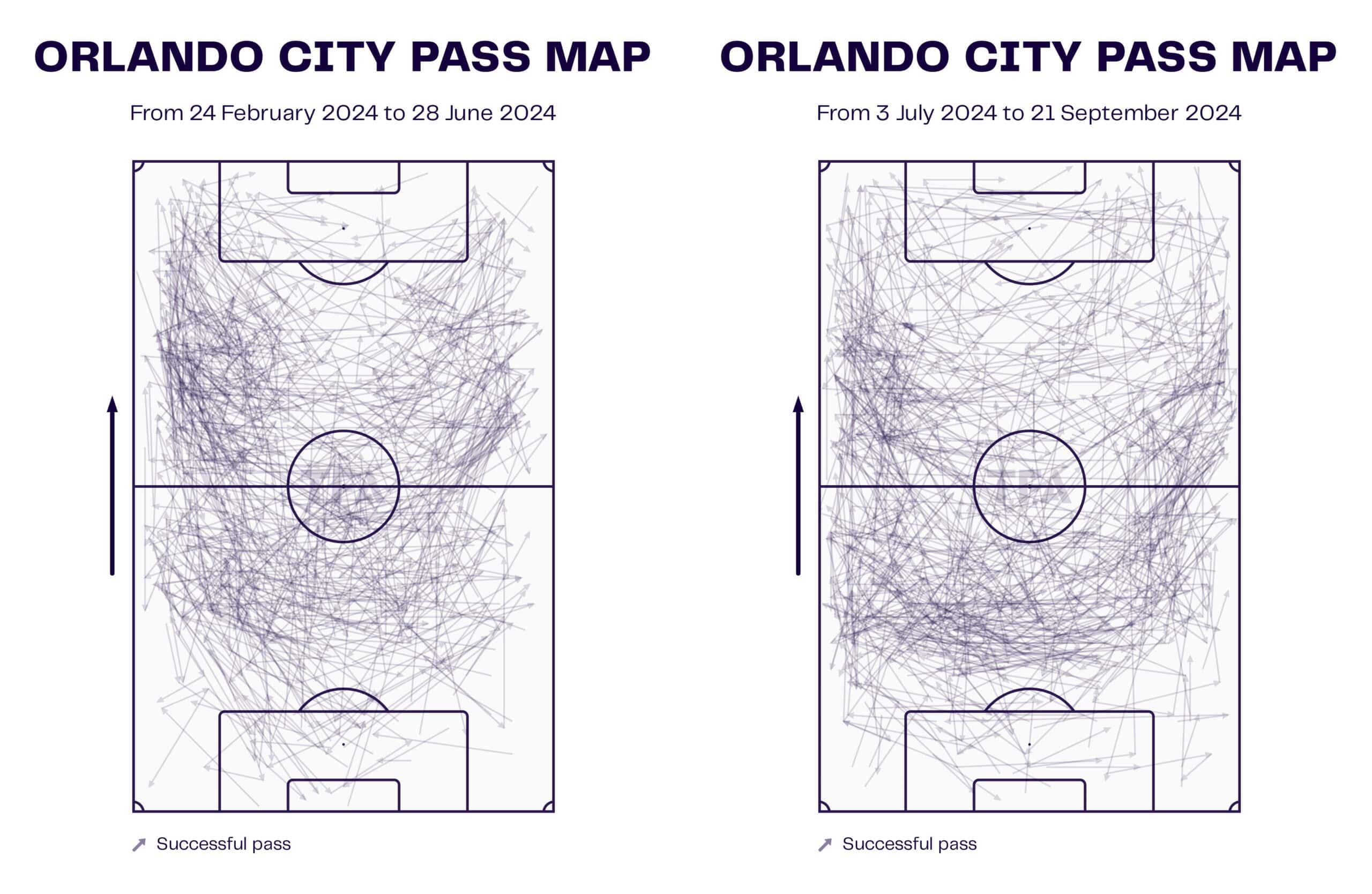
As we can see by the above pass maps, a couple of things seem clear.
Compared to the first twenty rounds of the season, Orlando’s recent upturn in form has noticeably seen more activity in the wider areas and better ball progression from the deeper central players to those occupying those spaces.
We can also notice a more even disparity between the flanks in the pic on the right side, with a more left-side heavy approach on the left.
Orlando’s attacks are more balanced now than they were earlier in the season, and one key element in that, besides the changes already mentioned, is the installation of Martín Ojeda as this team’s #10.
A few more changes that should be noted from Orlando’s recent run as follows.
Orlando City was also affected by the summer international tournaments going on around the globe, with the Euros, Copa América, and Olympics taking away the likes of Pedro Gallese, Wilder Cartagena, David Brekalo, and the aforementioned McGuire at different points.
Upon their return, Gallese and Cartagena were drafted back into the starting XI as expected.
However, due to the system change, Cartagena was drafted back into midfield, having previously been placed in central defence.
Together with César Araújo, they formed a double pivot that has laid a foundation for the team’s recent improvements, both offensively and defensively, which we’ll look at more shortly.
The two players who fell out of the team with the system change ended up being David Brekalo, who just did not fit in Pareja’s picture with one less centre-half in the system, and Nico Lodeiro, who, at 35, can’t go the way he once did.
And with the Argentine DP Ojeda returning from injury, Pareja found another solution to plug into that #10 role behind the striker, and he hasn’t looked back ever since.
From a defensive standpoint, let’s examine the tactical structure of Pareja’s preferred 4-2-3-1 system in action.
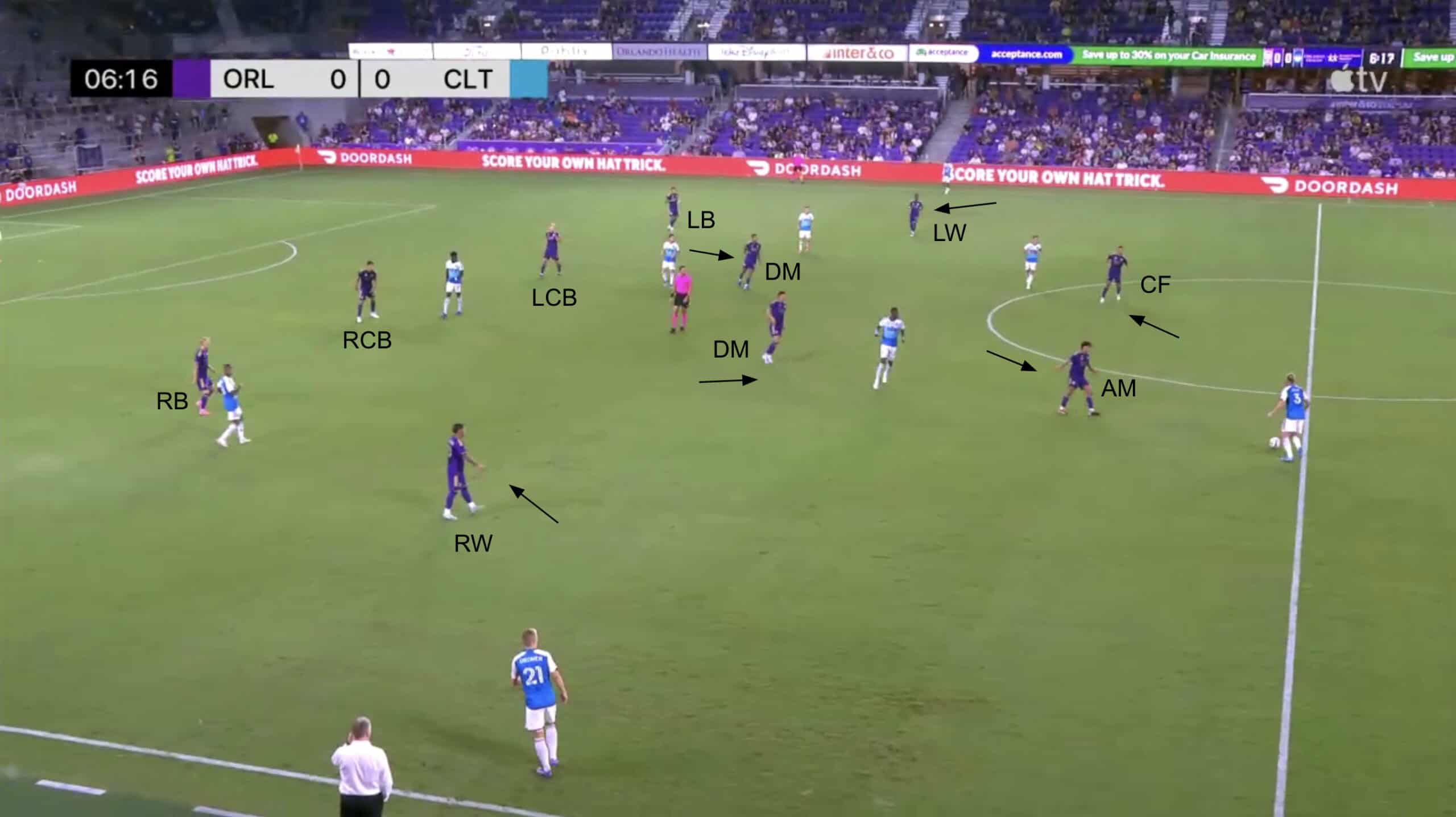
Above, we can see an example of Orlando’s basic shape out of possession from the recent home meeting with Charlotte.
Torres and Angulo drop deeper to be in the same line with Araújo and Cartagena, who push higher up in order to try to close down their opposite numbers from receiving or even nick the ball off them in case it’s attempted to be played to them from the back.
Ojeda pushes up alongside McGuire to create a 4-4-2 shape, which, in this graphic, allows Orlando to have a covering player on either side of every Charlotte option present in the attacking half.
This ends up forcing the defender to play the ball backwards, as there is nowhere to go, which invites further pressure on his team. Orlando players push up even higher to try to pin them back and regain possession.
This is a good example of their basic defensive structure.
Later in this analysis, we will discuss their pressing routine.
Orlando City Transitional Attacks
Pareja’s teams have always been known for their counterattacking football, breaking away with as many players joining the attack as quickly and efficiently as possible.
While players from all areas of the field are instructed to move forward when they sense an opportunity to get involved offensively, this is particularly the case for the wider players.
Pareja’s counter offence has always been predicated on having quick wide players who are able to beat their man and arrive in the box to get on the end of attacks, with a creative fulcrum in midfield pulling the strings in quick transitions to get the ball to their feet.
Intelligent movement is also an important factor when so many bodies join attacks to create proper spacing and confuse the opposition, and we’ll see two good examples below.
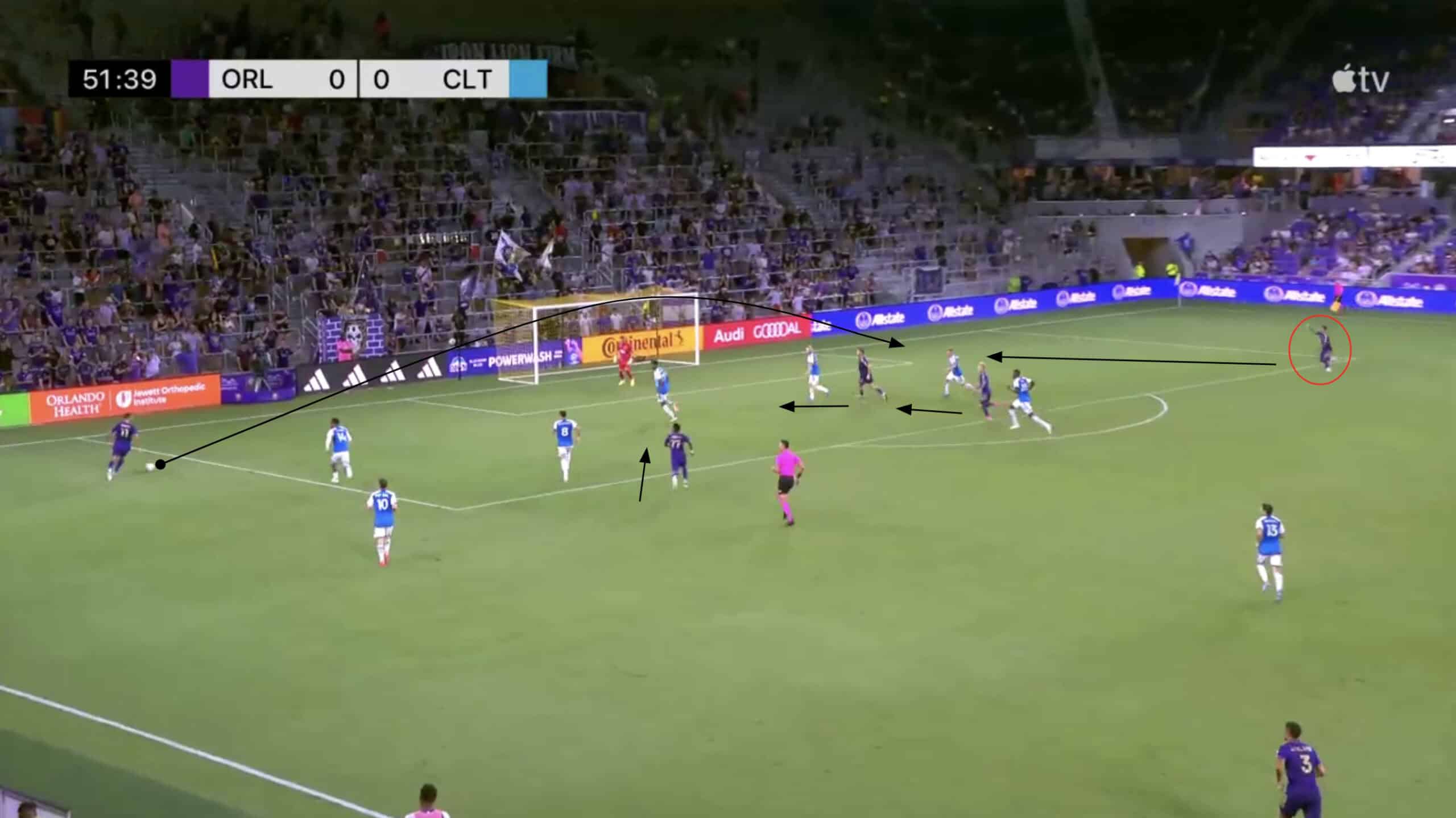
First, here’s an example from their most recent win at home to Charlotte.
Initially, McGuire makes the run from his central striker position, leaving Charlotte’s central defenders without a focal point to man mark.
He moves into the left-hand channel and is played in by Angulo, who curves his run to join the numbers in the box for the cross.
With Charlotte’s attention on the late-arriving Orlando players moving towards the goal, Torres is unchecked at the far side of the penalty area.
As we can see in the graphic, Torres lifts his arm up to signal to McGuire that he is in space to get a shot away at goal as he moves towards the post where there’s room to move into and potentially score, which he eventually does when the ball arrives at his feet.
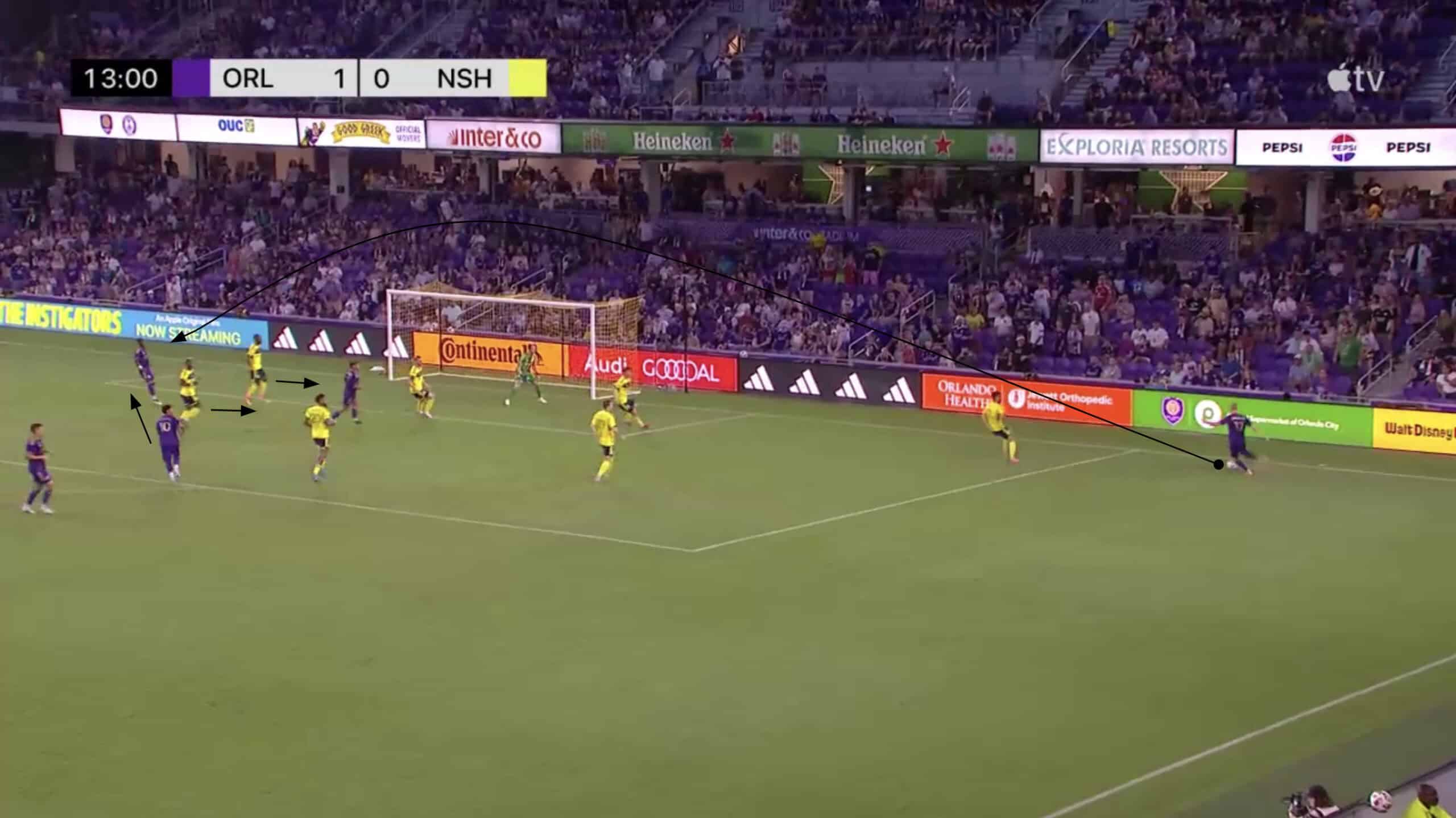
Here’s another example from the Nashville home game: Torres initially plays the ball out wide right to the overlapping Thorhallsson before continuing his run into the box to get on the end of the cross.
He eventually moves into the space where the arrow is pointing, free as a bird.
None of the Nashville defenders pays attention to his movement; instead, they anticipate the ball coming into the six-yard box.
Instead, Thorhallsson went far where Torres timed his arrival into that space well and finished as clinically as ever.
Both examples above display Orlando’s improvement in finding more success and breakthroughs in the crossing zones, which we’ll examine more below.
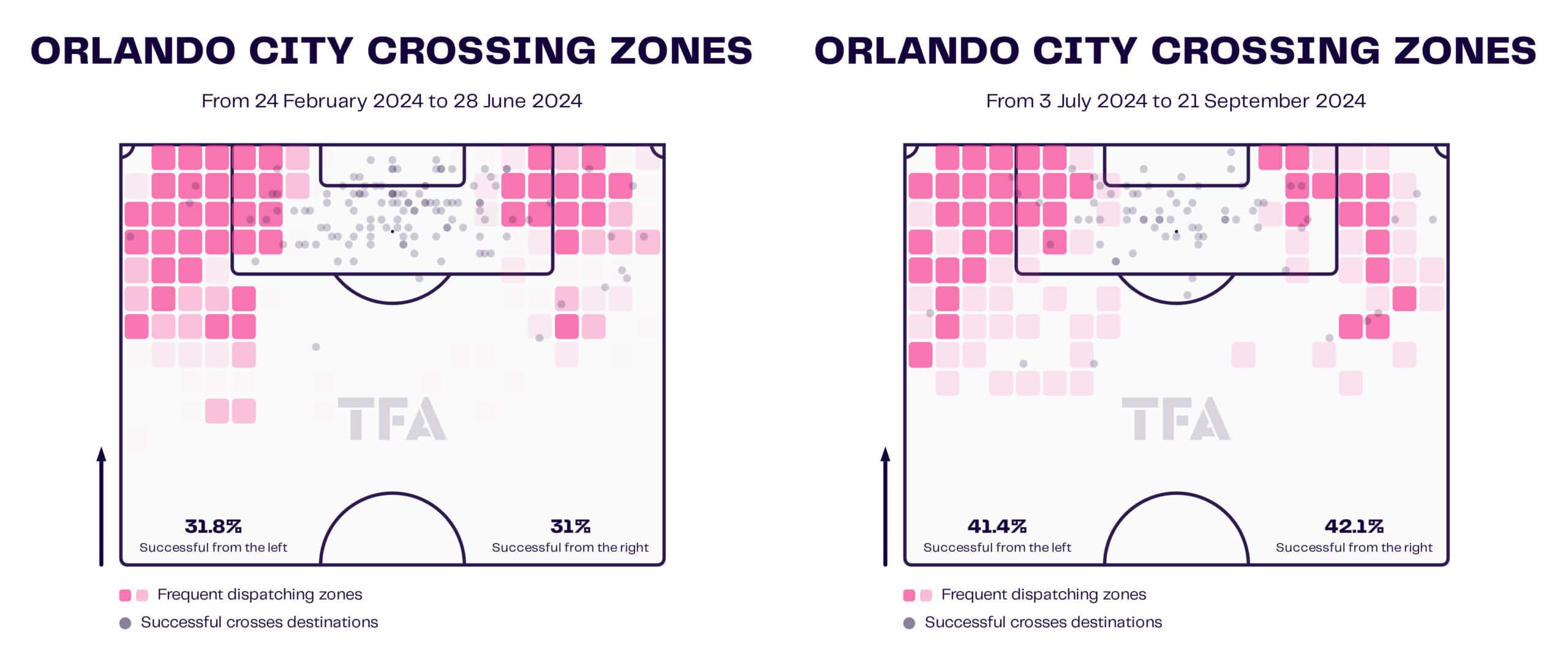
The data viz above exemplifies those improvements in the crossing zones, with a 10% increase in the effectiveness of the balls delivered into the box from both sides compared to the earlier part of the season.
As mentioned earlier, there’s a more even disparity now between the two flanks that their attacks primarily run through, and this has, in part, brought more success to them offensively.

Another example of their quick transitional play is their occasional use of a long ball to a forward player in space, which puts them in a 1v1 situation against an opposing defender.
That’s what the graphic above from the Toronto game shows here.
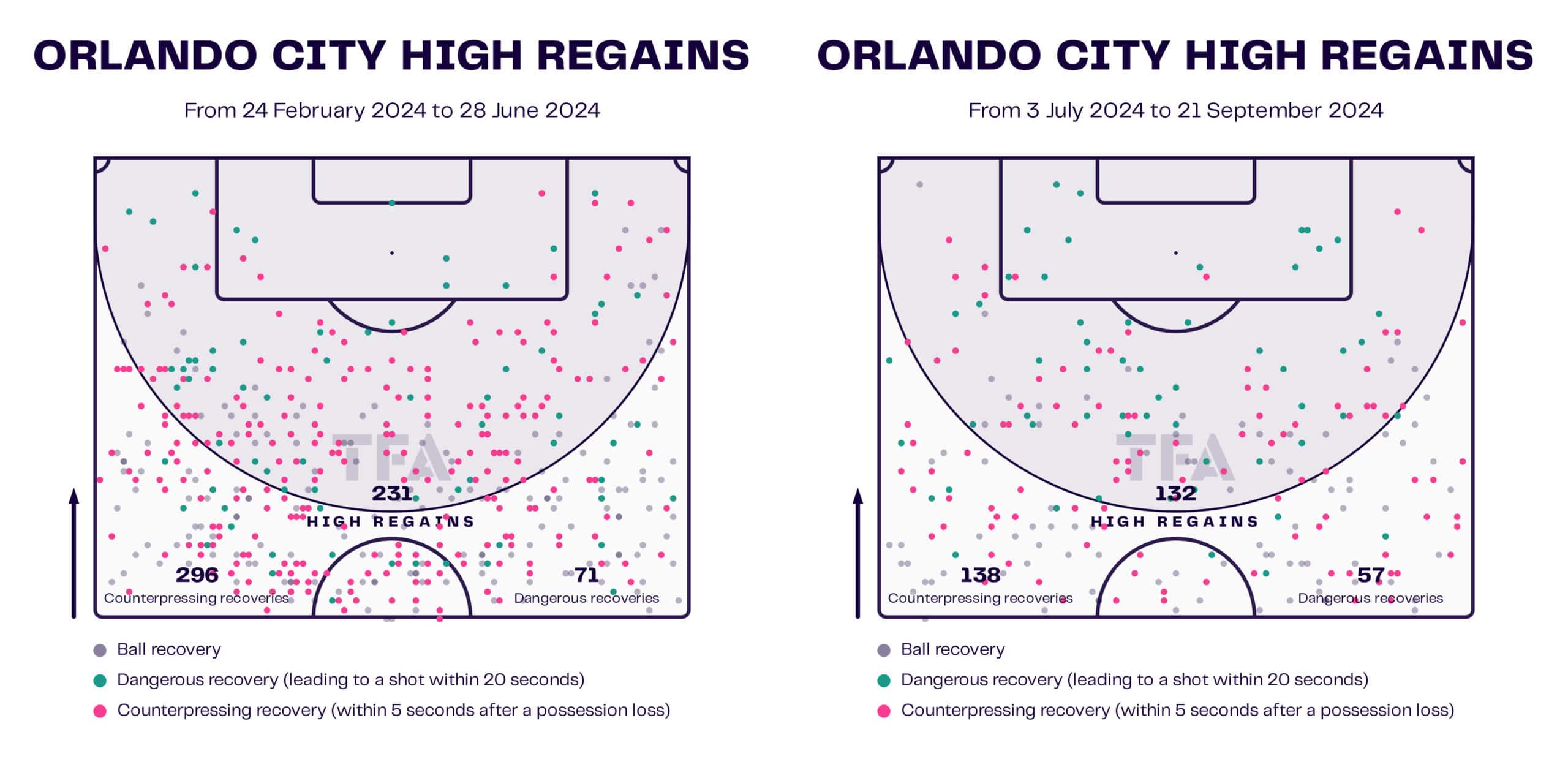
The data viz above highlights the differences between Orlando’s counterpressing and recoveries from the earlier phase of the campaign to their recent green run.
The main thing that stands out here is that they made just 14 less dangerous recoveries in half as many games, leading to an average of over 5.0 per game compared to only about 3.5 in the picture on the left side.
It also appears that many of those dangerous recoveries take place closer to or inside the opposition’s penalty area, which is a testament to their pressing strategy, which is a big part of both their defence and attack under Pareja.
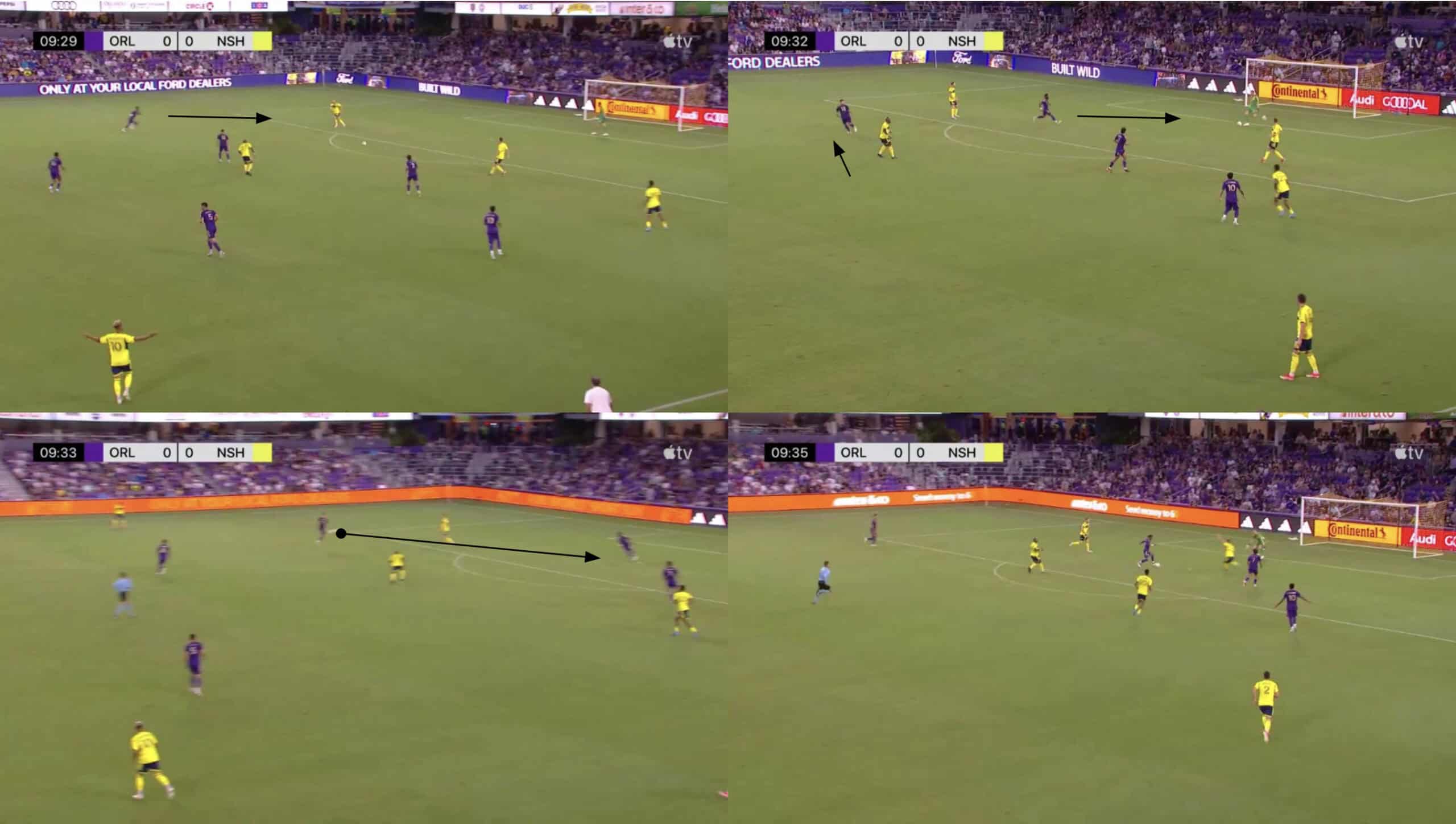
A great example of Pareja’s counter-pressing ploy in action can be found above from the Nashville home game.
The play begins with Nashville trying to build from the back with the ball coming towards their right centre-back.
In the first picture, you can see Angulo sprinting across from the left wing, trying to close him down before the ball even gets to him.
The defender ends up playing it back first time to his keeper to avoid danger.
In the second picture, we can see Angulo continuing his run across to close down the ball and Ojeda moving wider to take up the space Angulo was in instead.
In the third picture, Nashville’s goalkeeper attempts to play a risky ball out wide to the right full-back, but it gets cut out by Ojeda.
He immediately feeds Angulo in the box to set him up for a 1v1 situation to score, which he does in picture four.
All of that commenced in about six seconds, which makes it a classic example of a good counterpressing strategy leading to winning possession and creating an opportunity to score in next to no time.
Orlando City Set-Piece Success
It’s hard to mention Orlando’s attacking success without referring to their set-piece abilities as a team.
Having scored a quarter of their goals from set plays this year and accumulated the second most corner kicks in the entire league, with 175 in total as of this writing, there’s no doubt about their effectiveness from dead-ball situations this year.
Let’s look at a couple of those goals and break down how they came about.
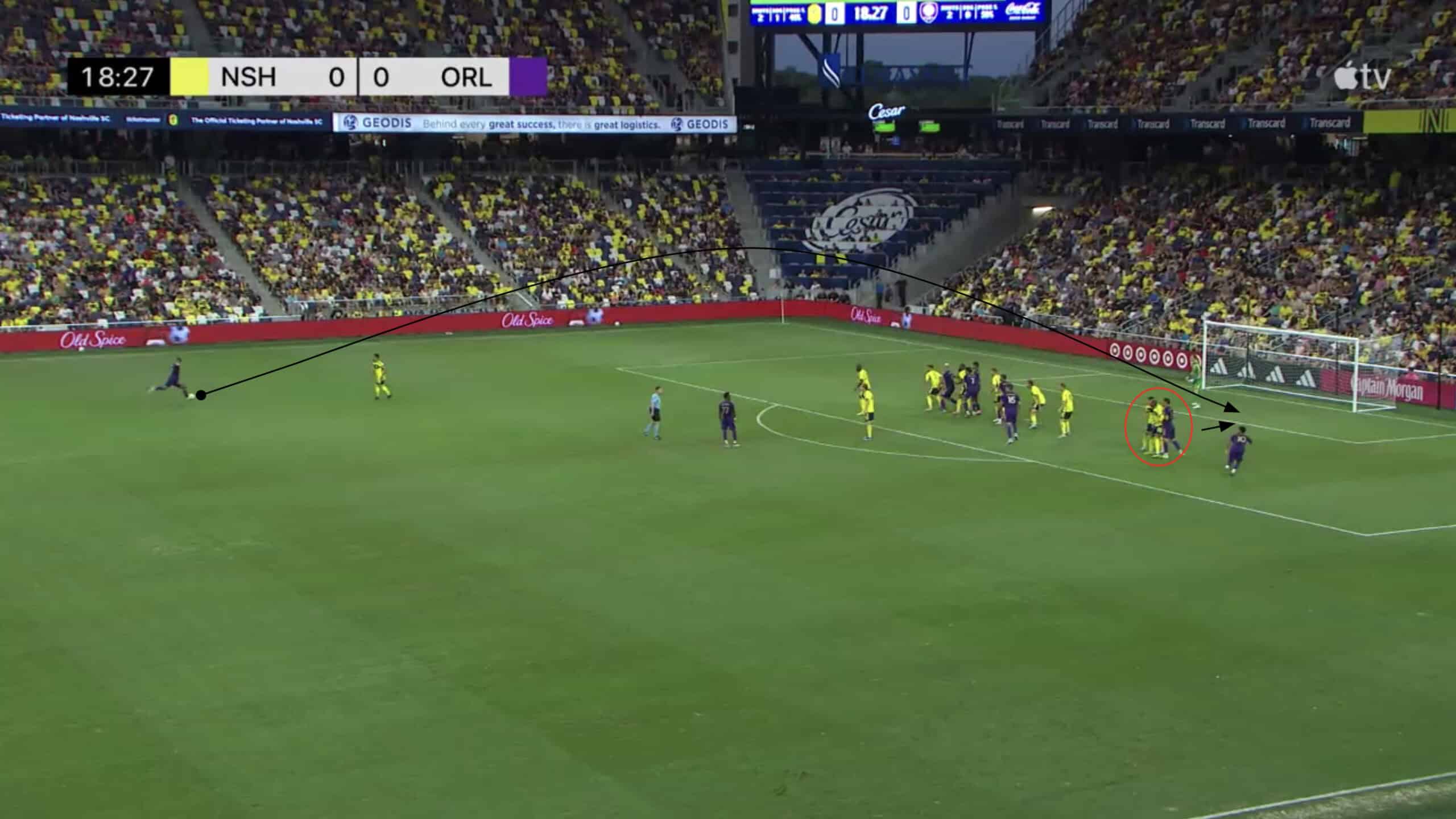
In the above example from the Nashville away game, we can see several Orlando players in the box playing off of their opponents initially as their starting positions as the freekick is set to be delivered by Martín Ojeda.
In the red circle, we can see Araújo starting on the blind side of a Nashville defender and Torres unmarked at the far post.
As the ball is swung in towards that area, Araújo is able to peel away from his marker and arrive to the six-yard box with a simple header that gave Orlando the lead.
Orlando managed to score a second goal in a similar manner, proving that Nashville didn’t learn their lesson and that Orlando’s routine paid full dividends.
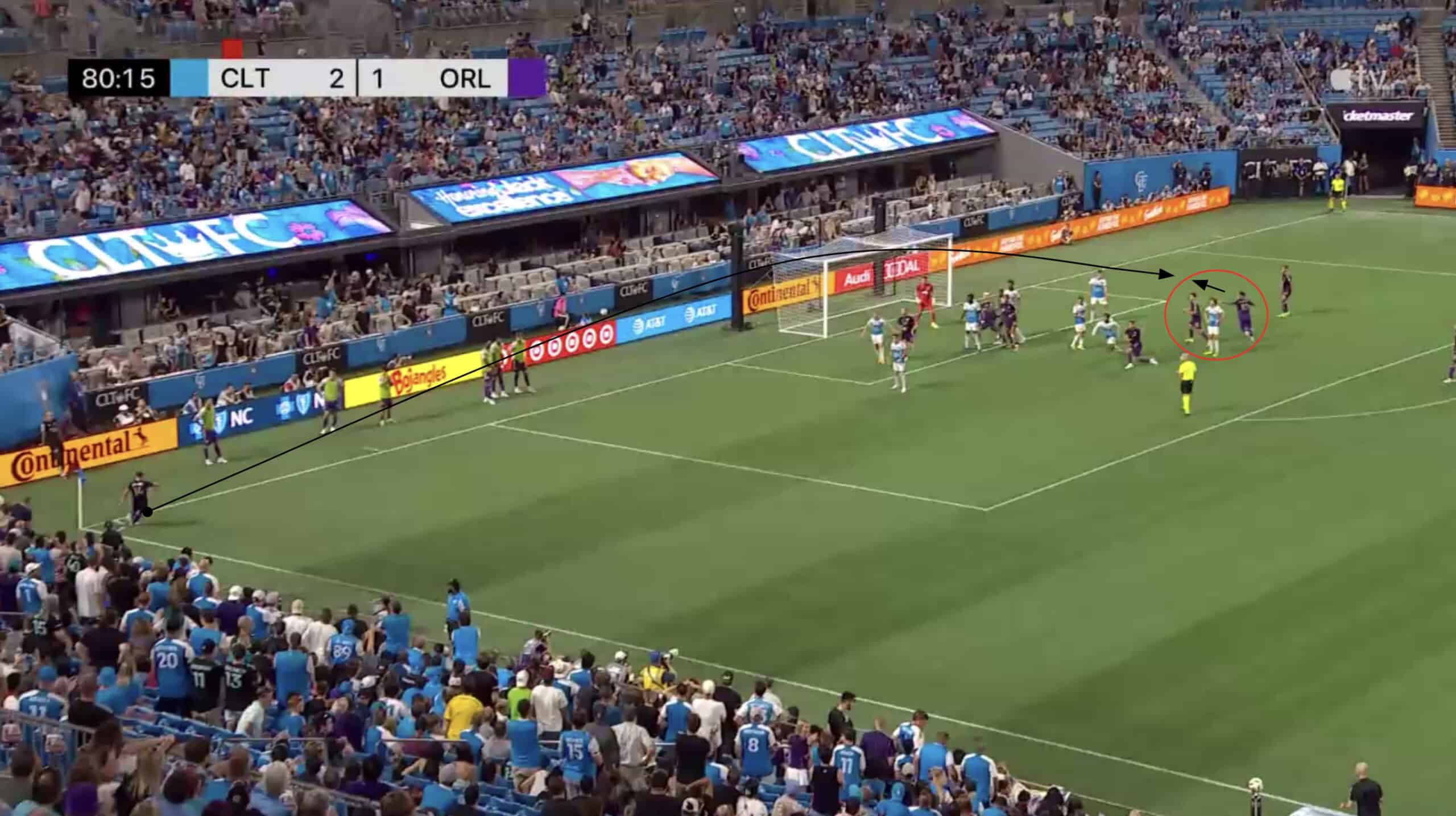
Another example here is from their first meeting with Charlotte this season, this time from a corner kick and, once again, an inswinging delivery from a left-footed player from the same side.
However, on this occasion, it was via the boot of Nico Lodeiro.
Once again, in the red circle, we can spot a situation in which Orlando has two options for the set-piece taker to aim at against a lone defender who cannot mark both simultaneously.
In this example, Torres is once again uncovered, allowing him to roam freely into the space on the blind side of the defender who doesn’t see him.
He eventually moves into exactly where Lodeiro places the ball with a pinpoint delivery, and Torres finishes clinically with his left foot for the equalizer.
Both examples are a display of Orlando using their numbers in the box well to create numerical advantages and opportunities to score, with some of the best dead-ball specialists in the league in their ranks to pick them out.
Despite the side’s lack of strong aerial presence, which we’ll learn more about later, they are able to find ways to score from set plays, using intelligent movement and situational awareness to make the chances they get from these count.
Orlando City Defensive Struggles
Statistically, Orlando have had one of the worst defenses in all of MLS in multiple categories this season.
They have conceded the sixth-most shots against, with the fifth-lowest saves percentage against those opportunities, hinting that perhaps goalkeeping is a weak point for them, with the 34-year-old Peruvian mostly in between the sticks.
Even more interestingly, they are ranked at the very bottom of the league when it comes to winning aerial duels and third from bottom in defensive clearances.
It’s perhaps not surprising, given that three of their first-choice back four are under 6 feet tall and only McGuire from the rest of their outfield starters.
This means they are at a clear disadvantage when it comes to competing aerially, especially on the defensive end.
Despite these stats and evident defensive frailties, Orlando have seen improvement overall in this area over the last ten rounds.
As per the current form table, Orlando are only behind Supporters’ Shield leaders Inter Miami when it comes to points won in the last ten games in the Eastern Conference standings.
What makes this run even more fascinating is the fact that they have both the best attack AND best defence during this period in the entire conference.
So, while they still have their issues at the back, they’ve found ways to lessen the blows they deal with in that area as part of a well-rounded dramatic improvement on both ends of the pitch in recent months.
Conclusion
Orlando City have been on an amazing run lately, one that even the most diehard Lions fan could hardly have foreseen two or three months ago.
They’ve managed to lift themselves and peak at the perfect moment, with the MLS Cup playoffs just around the corner and Orlando now very likely to participate in them.
Rather than looking to creep into a wild-card berth, which at one point looked the most likely route for them, they are now seeking to finish as high as possible in the East, with fourth place in their sights.
The sky could well be the limit for this talented Orlando team now, as they seek to improve on a Conference Semifinal appearance in last year’s playoff exit to eventual champions Columbus Crew.
Having won their first major honor as a franchise in 2022 with the U.S. Open Cup, it will be interesting to see if they can add an MLS Cup title to their cabinet by the end of the year.
As one of the most in-form sides in the league at the moment, they will certainly fancy that challenge.






Comments